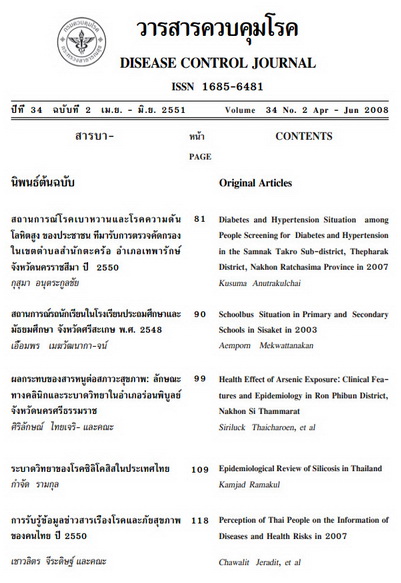Health Effect of Arsenic Exposure: Clinical Features and Epidemiology in Ron Phibun District, Nakhon Si Thammarat
Keywords:
Arsenic, Arsenicosis, Chronic Arsenic Poisoning, Ronpibun HospitalAbstract
The study determined the various clinical signs and symptoms of health effect associated with arsenic exposure and also the prevalence rate in Ron Phibun district, Nakhon Si Thammarat during July 2005 and June 2006. This cross - sectional survey involving 6,167 participants of all ages was conducted in village 2, 12 and 13 Ron phibun Subdistric, Ron phibun District, Nakhon Si Thammarat Province, where tin-mining had been undertaken for about a century and leaving arsenic contamination in well-water of more than 0.2 mg./L. Each participant was asked about water use in drinking and cooking, past history of major illness and clinical examinations were carried out taking special care to detect abnormal skin lesions. Of 6,167 participants, 2,344 people had exposed. In the exposed population, 23.5% showed at least one of the cutaneous signs of chronic arsenic poisoning. The most common cutaneous signs were palm and sole keratosis. Rain-drop pigmentation was the most common abnormal pigmentation. The prevalence of skin cancer in the exposed population was 1.88%.
References
2. Guha Mazumder D.N. Chronic Arsenic Toxicity: Clinical Features, Epidemiology and Treatment: Experience in West Bengal. Journal of Environmental Science and Health. 2003; 38: 141-163
3. Tseng WP, Chu HM, How SW, et al. Prevalence of skin cancer in an endemic area to chronic arsenism in Taiwan. J Natl Cancer Inst 1968: 40: 453-63.
4. Borgono JM, Vicent P, Venturino H, et al. Arsenic in the drinking water of the city of Antofagasta: epidemiological and clinical study before and after the installation of a treatment plant. Environ Health Perspect 1977; 19: 103-5.
5. Cebrian ME. Albores A, Aguilar M, et al. Chronic arsenic poisoning in the North of Mexico. Hum Toxicol 1983; 2: 121-33.
6. Smith AH, Lingas EO, Rahman M. Contamination of drinking water by arsenic in Bangladesh: a public health emergency. Bull World Health Organ. 2007; 78: 1093-1103.
7. WHO/SEARO. A Field Guide for Detection, Management and Surveillance of Arsenicosis. WHO Technical Publication N.SEA/EH/545. 2004.
8. Beckman G, Beckman L, Nordenson I. Chromosome aberration in workers exposed to arsenic. Environ Health Perspect 1977; 119: 145-146.
9. Chen C-J, Kuo T-L, Wu M-M. Arsenic and and cancers. Lancet 1988; 1: 414-15.
10. Chen C-J, Chuang Y-C, Lin T-M, et al. Malignant neoplasm among residents of a blackfoot disease-endemic area in Taiwan: high-arsenic artesian well water and cancers. Cancer Res 1985; 45: 5895-9.
11. Bates MN, Smith AH. Arsenic ingestion and internal cancer: a review. Am J Epidemiol 1992; 135: 462-76.
12. Tsuda T, Babazono A, Yamamoto E, et al. Ingested arsenic and internal cancer: historical cohort study followed 33 years. Am J Epidemiol 1995; 141: 198-219.
13. Miki et al. Cutaneous and pulmonary cancers associated with Bowen's disease. Journal of the American Academy of Dermatology. 1982; 6: 26-31.
14. Schwartz RA. Arsenic and the skin. Int J dermatol 1997; 36: 241-250.
15. The Office of National Environmental Board. Report of Arsenic Contents of Well Waters in Ronphibun District, Nakorn si thammarat Province. O.N.E.B., Bangkok. 1987.
Downloads
Published
How to Cite
Issue
Section
License
Articles published in the Disease Control Journal are considered as academic work, research or analysis of the personal opinion of the authors, not the opinion of the Thailand Department of Disease Control or editorial team. The authors must be responsible for their articles.



.png)



